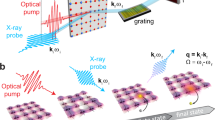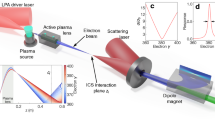Abstract
Ultrafast X-ray science is an exciting frontier that promises the visualization of electronic, atomic and molecular dynamics on atomic time and length scales. A largely unexplored area of ultrafast X-ray science is the use of light to control how X-rays interact with matter. To extend control concepts established for long-wavelength probes to the X-ray regime, the optical control field must drive a coherent electronic response on a timescale comparable to femtosecond core-hole lifetimes. An intense field is required to achieve this rapid response. Here, an intense optical control pulse is observed to efficiently modulate photoelectric absorption for X-rays and to create an ultrafast transparency window. We demonstrate an application of X-ray transparency relevant to ultrafast X-ray sources: an all-photonic temporal cross-correlation measurement of a femtosecond X-ray pulse. The ability to control X-ray–matter interactions with light will create new opportunities for present and next-generation X-ray light sources.
This is a preview of subscription content, access via your institution
Access options
Subscribe to this journal
Receive 12 print issues and online access
$209.00 per year
only $17.42 per issue
Buy this article
- Purchase on Springer Link
- Instant access to full article PDF
Prices may be subject to local taxes which are calculated during checkout


 ɛX).
ɛX).



Similar content being viewed by others
References
Cavalleri, A. et al. Band-selective measurements of electron dynamics in VO2 using femtosecond near-edge X-ray absorption. Phys. Rev. Lett. 95, 067405 (2005).
Fritz, D. M. et al. Ultrafast bond softening in bismuth: Mapping a solid’s interatomic potential with X-rays. Science 315, 633–636 (2007).
Bressler, Ch. et al. Femtosecond XANES study of the light-induced spin crossover dynamics in an iron (II) complex. Science 323, 489–492 (2009).
Chen, L. X. Taking snapshots of photoexcited molecules in disordered media by using pulsed synchrotron X-rays. Angew. Chem. Int. Edn 43, 2886–2905 (2004).
Bressler, C. & Chergui, M. Ultrafast X-ray absorption spectroscopy. Chem. Rev. 104, 1781–1812 (2004).
Hertlein, M. P. et al. Inner-shell ionization of potassium atoms ionized by a femtosecond laser. Phys. Rev. A. 73, 062715 (2006).
Young, L. et al. X-ray microprobe of orbital alignment in strong-field ionized atoms. Phys. Rev. Lett. 97, 083601 (2006).
Peterson, E. R. et al. An X-ray probe of laser aligned molecules. Appl. Phys. Lett. 92, 094106 (2008).
Harris, S. E. Electromagnetically induced transparency. Phys. Today 50, 36–42 (1997).
Fleischhauer, M., Imamoglu, A. & Marangos, J. P. Electromagnetically induced transparency: Optics in coherent media. Rev. Mod. Phys. 77, 633–673 (2005).
Harris, S. E. Nonlinear optics at low light levels. Phys. Rev. Lett. 82, 4611–4614 (1999).
Loh, Z. H., Greene, C. H. & Leone, S. R. Femtosecond induced transparency and absorption in the extreme ultraviolet by coherent coupling of the He 2s2p (1P0) and 2p2 (1Se) double excitation states with 800 nm light. Chem. Phys. 350, 7–13 (2008).
Arthur, J. et al. Linac coherent light source (LCLS) design study report, SLAC Report No. SLAC-R-593, UC-414 (SLAC, 2002).
Altarelli, M. et al. DESY Report No. 2006-097 (DESY, 2006).
Tanaka, T. & Shintake, T. SCSS X-FEL conceptual design report, (RIKEN Harima Institute/Spring-8, 2005).
DeCamp, M. F. et al. Coherent control of pulsed X-ray beams. Nature 413, 825–828 (2001).
Grigoriev, A. et al. Subnanosecond piezoelectric X-ray switch. Appl. Phys. Lett. 89, 021109 (2006).
Buth, C., Santra, R. & Young, L. Electromagnetically induced transparency for X-rays. Phys. Rev. Lett. 98, 253001 (2007).
Brumer, P. W. & Shapiro, M. Principles of the Quantum Control of Molecular Processes (Wiley, 2003).
Schweigert, I. V. & Mukamel, S. Coherent ultrafast core-hole correlation spectroscopy: X-ray analogues of multidimensional NMR. Phys. Rev. Lett. 99, 163001 (2007).
Varma, H. R., Pan, L., Beck, D. R. & Santra, R. X-ray absorption near-edge structure of laser-dressed neon. Phys. Rev. A 78, 065401 (2008).
Buth, C. & Santra, R. Theory of X-ray absorption by laser-dressed atoms. Phys. Rev. A 75, 033412 (2007).
Autler, S. H. & Townes, C. H. Stark effect in rapidly varying fields. Phys. Rev. 100, 703–722 (1955).
Littman, M. G., Kash, M. M. & Kleppner, D. Field-ionization processes in excited atoms. Phys. Rev. Lett. 41, 103–107 (1978).
Agrawal, G. S. Nature of the quantum interference in electromagnetically-field-induced control of absorption. Phys. Rev. A 55, 2467–2470 (1997).
Imamoglu, A. & Harris, S. E. Lasers without inversion: Interference of dressed lifetime-broadened states. Opt. Lett. 14, 1344–1346 (1989).
Steier, C. et al. Successful completion of the femtosecond slicing upgrade at the ALS. Particle Accelerator Conference, PAC. IEEE 25–29, 1194–1196 (2007).
Meyer, M. et al. Two-color photoionization in xuv free-electron and visible laser fields. Phys. Rev. A 74, 011401(R) (2006).
Schoenlein, R. W. et al. Femtosecond pulses of synchrotron radiation: A new tool for ultrafast time-resolved X-ray spectroscopy. Science 287, 2237–2240 (2000).
Khan, S. et al. Femtosecond undulator radiation from sliced electron bunches. Phys. Rev. Lett. 97, 074801 (2006).
Beaud, P. et al. Spatiotemporal stability of a femtosecond hard–X-ray undulator source studied by control of coherent optical phonons. Phys. Rev. Lett. 99, 174801 (2007).
Coreno, M. et al. Measurement and ab initio calculation of the Ne photoabsorption spectrum in the region of the K edge. Phys. Rev. A 59, 2492–2497 (1999).
Acknowledgements
We thank C. Buth and S.E. Harris for enlightening discussions and D.L. Ederer, T. Weber, R.W. Schoenlein and P. Heimann for experimental support during early stages of this project. This work was supported by the Chemical Sciences, Geosciences, and Biosciences Division of the Office of Basic Energy Sciences, Office of Science, US Department of Energy, under Contract No. DE-AC02-06CH11357 and DE-AC02-05CH11231. This work was carried out at the Advanced Light Source, Lawrence Berkeley National Laboratory, and was supported by the Office of Science, Office of Basic Energy Sciences, of the US Department of Energy under Contract No. DE-AC02-05CH11231.
Author information
Authors and Affiliations
Contributions
T.E.G., M.P.H., A.B., S.H.S. and L.Y. contributed to the design of the experiment. T.E.G., M.P.H. and B.R. were responsible for the femtosecond X-ray beamline and control laser performance. T.E.G., M.P.H., S.H.S., T.K.A., J.V.T., E.P.K., B.K. and L.Y. collected the data. H.R.V. and R.S. carried out the supporting theoretical calculations. Data analysis and interpretation were done by S.H.S., T.E.G., M.P.H., E.P.K., R.S. and L.Y.
Corresponding author
Rights and permissions
About this article
Cite this article
Glover, T., Hertlein, M., Southworth, S. et al. Controlling X-rays with light. Nature Phys 6, 69–74 (2010). https://doi.org/10.1038/nphys1430
Received:
Accepted:
Published:
Issue Date:
DOI: https://doi.org/10.1038/nphys1430
This article is cited by
-
Optomechanically induced transparency of x-rays via optical control
Scientific Reports (2017)
-
Coherence and resonance effects in the ultra-intense laser-induced ultrafast response of complex atoms
Scientific Reports (2016)
-
Gravitational and relativistic deflection of X-ray superradiance
Nature Photonics (2015)
-
Single-shot spectro-temporal characterization of XUV pulses from a seeded free-electron laser
Nature Communications (2015)
-
Sub-cycle Oscillations in Virtual States Brought to Light
Scientific Reports (2013)



